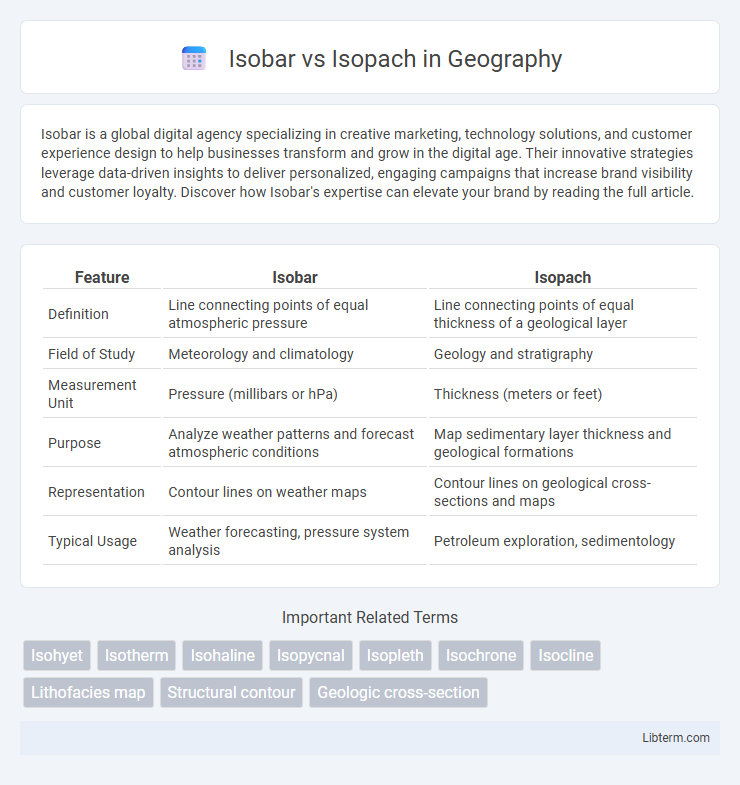Isobar is a global digital agency specializing in creative marketing, technology solutions, and customer experience design to help businesses transform and grow in the digital age. Their innovative strategies leverage data-driven insights to deliver personalized, engaging campaigns that increase brand visibility and customer loyalty. Discover how Isobar's expertise can elevate your brand by reading the full article.
Table of Comparison
| Feature | Isobar | Isopach |
|---|---|---|
| Definition | Line connecting points of equal atmospheric pressure | Line connecting points of equal thickness of a geological layer |
| Field of Study | Meteorology and climatology | Geology and stratigraphy |
| Measurement Unit | Pressure (millibars or hPa) | Thickness (meters or feet) |
| Purpose | Analyze weather patterns and forecast atmospheric conditions | Map sedimentary layer thickness and geological formations |
| Representation | Contour lines on weather maps | Contour lines on geological cross-sections and maps |
| Typical Usage | Weather forecasting, pressure system analysis | Petroleum exploration, sedimentology |
Introduction to Isobar and Isopach
Isobars are contour lines on maps that connect points of equal atmospheric pressure, commonly used in meteorology to analyze weather patterns. Isopachs, in contrast, are lines that connect points of equal thickness, often applied in geology and sedimentology to represent the thickness of sedimentary layers. Both tools provide critical spatial data visualization but focus on different types of measurement--pressure for isobars and layer thickness for isopachs.
Definition of Isobar
An isobar is a line on a map or chart connecting points of equal atmospheric pressure, commonly used in meteorology to analyze weather patterns and forecast changes. Unlike an isopach, which depicts thickness variations within geological layers, isobars reflect pressure variations influencing wind speed and direction. Understanding isobars is crucial for interpreting pressure systems and predicting weather phenomena such as storms and high-pressure zones.
Definition of Isopach
Isopach maps represent the thickness of a particular geological layer by recording the vertical distance between its top and bottom surfaces, measured perpendicular to the stratigraphic beds. Unlike isobar maps, which depict pressure variations at specific depths or levels, isopach maps emphasize spatial thickness variations across a region. These maps are crucial in sedimentology and petroleum geology for analyzing reservoir distribution and volume estimation.
Key Differences Between Isobar and Isopach
Isobar maps connect points of equal atmospheric pressure, while isopach maps delineate thickness variations in geological strata or sediment layers. Isobars are crucial in meteorology for weather analysis, indicating pressure systems and wind patterns, whereas isopachs are vital in geology and petroleum exploration to assess reservoir thickness and sediment accumulation. The primary difference lies in their measurement focus: isobars represent pressure values on a surface, and isopachs represent vertical thickness between geological horizons.
Applications of Isobar in Meteorology
Isobars are crucial in meteorology for mapping atmospheric pressure variations on weather charts, helping forecast wind patterns and storm systems by connecting points of equal pressure. They enable meteorologists to identify high- and low-pressure areas, analyze pressure gradients, and predict weather changes like cyclones or anticyclones. Unlike isopachs, which measure thickness and are used in geology and geophysics, isobars specifically assist in understanding and visualizing atmospheric dynamics.
Applications of Isopach in Geology
Isopach maps, illustrating thickness variations of sedimentary layers, play a crucial role in geological applications such as resource exploration, stratigraphic correlation, and reservoir characterization. These maps help geologists identify depositional environments, estimate sediment volumes, and assess the distribution of subsurface resources like oil, gas, and minerals. Unlike isobar maps, which represent pressure variations, isopach maps provide detailed insights into the spatial thickness changes essential for sedimentological and structural analysis.
Methods of Creating Isobar Maps
Isobar maps are created by connecting points of equal atmospheric pressure using data collected from weather stations, satellites, and radar systems, often processed through interpolation techniques and numerical weather prediction models to generate smooth contour lines. In contrast, isopach maps, which represent thickness variations of geological or sedimentary layers, are produced by measuring layer thickness at multiple points through well logs, seismic surveys, or drilling data, and then applying interpolation methods such as kriging, inverse distance weighting, or spline to delineate contours of equal thickness. The precision of isobar maps relies heavily on real-time meteorological data integration, whereas isopach maps depend on subsurface geological measurements and geostatistical analysis.
Techniques for Drawing Isopach Maps
Isopach maps represent thickness variations of sedimentary layers, requiring techniques such as interpolation of well log data and contouring thickness measurements between wells for accurate depiction. Common methods include kriging and inverse distance weighting (IDW) to estimate thickness values across spatial points, enhancing map precision. Digital tools like GIS software streamline the generation of isopach maps by integrating digitized well data and performing spatial analysis to produce smooth, informative thickness contours.
Importance of Isobar and Isopach in Earth Sciences
Isobars are crucial in meteorology and oceanography for illustrating areas of equal atmospheric pressure, aiding in weather prediction and climate studies. Isopachs represent thickness variations within sedimentary layers or geological formations, essential for analyzing stratigraphic sequences and reservoir characterization in petroleum geology. Both tools enable earth scientists to interpret spatial distribution and temporal changes in environmental and geological phenomena accurately.
Summary: Choosing Between Isobar and Isopach
Isobar maps represent lines of equal pressure in meteorology or equal values in different scientific fields, highlighting pressure distribution or parameter constancy. Isopach maps illustrate thickness variations, commonly used in geology and sedimentology to show formation thickness or deposition rates. Choosing between isobar and isopach depends on the focus--pressure or value constancy favors isobar, while thickness or interval measurement requires isopach for effective spatial analysis.
Isobar Infographic

 libterm.com
libterm.com